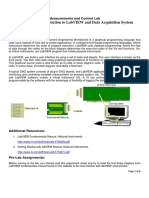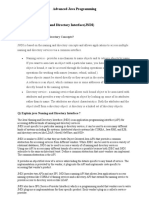Tutorial 16 - Graphics and Imaging: The Canvas
Uploaded by
Fatima AbdurahamanTutorial 16 - Graphics and Imaging: The Canvas
Uploaded by
Fatima AbdurahamanTutorial 16 - Graphics and Imaging
Graphics brings life to applications. JavaScript allows creation and modification of images using HTML5 canvasobjects. This basic tutorial introduces some fundamental concepts of graphics and imaging. A more complete tutorial can be found at Mozilla's Canvas Tutorial.
The Canvas Shapes&Pat hs
Styles & Patterns Transforms&Composit es
Using Imag es Text, Shad ows, Fonts
The Canvas
HTML 5 introduces the canvas element which allows JavaScript 2D objects to be used in documents. Artists tend to think in terms of a canvas surface as the foundation for their images and graphics. The canvas origin (0,0) is set at theupper left corner. Output to the canvas takes place through a graphics context encapsulated by the Graphics class.
<canvas id="canvas" width='100' height='100'> <p>Sorry: Browser does not support Graphics Canvas</p></canvas>
Note: Not all browsers implement the canvas element. Include either a text or image element inside any canvas element to warn users! Also use getContext(apiName) to escape functions that require canvas! Look ahead in the tutorial for Shapes and Styles.
Show Graphic
Shapes and Paths
There is only one primitive shape: the rectangle. It has three constructors: clearRect(x,y,width,height),fillRect(x,y,width,height) and strokeRect(x,y,width,height). Paths are used for more complex shapes. Paths are drawn with beginPath(), moveTo(x,y) [pen up], lineTo(x,y) [pen down], closePath(), stroke() [for outlines] and fill() [for filled shapes].
Show Graphic
Arcs are drawn with arc(x,y,radius,sAng,eAng,rotFlag). sAng and eAng are in radians (note: a simple conversion isvar radians=(Math.PI/180)*degrees). rotFlag is boolean.
Show Graphic
Show Graphic
Bezier curves are used to draw complex shapes. They have either one: quadraticCurveTo(cp1x,cp1y,x,y) or two:bezierCurveTo(cp1x,cp1y,cp2x,cp2y,x,y)control points.
Show Graphic
Styles and Patterns
Fill patterns control how a drawn object is filled in with ink. Color is the common fill pattern used. Inkwells are filled with fillStyle=colorVal and strokeStyle=colorVal. colorVal has several formats: hex (eg #rrggbb), named (eg red), rgb (eg rgb(r, g, b)) and alphaTransparency (eg rgba(r, g, b, a). Line strokes can be styled in several ways. The properties are lineWidth [int], lineCap [butt|round|square] and lineJoin [round|bevel|mitre]. mitreLimit can be set and if exceeded bevel style is forced.
Gradient objects are created with createLinearGradient(x1, y1, x2, y2) or createRadialGradient(x1, y1, r1, x2, y2, r2). colors are added with addColorStop(posn, colorVal). posn can be from 0 to 1.
Show Graphic
Pattern objects are created with createPattern(img, repVal). repVal is one of repeat, repeat-x, repeat-y, no-repeat. Refer to next section for img.
Transformations & Composites
Transformation methods include translate, rotate, scale and the generic transform. Objects are normally placed on top of the canvas, covering previous objects. globalCompositeOperation allows placing under another object or other more complex method of masking. Clipping provides complex masking screens.
Using Images
Images can be loaded from a file and drawn to the canvas for editing. Preloading is recommended. They can then be scaled and/or sliced (ie cropped).
Show Graphic
Text, Shadows, Fonts
Text can be added to a canvas using the properties: font, textAlign & textBase; and the methods: fillText(txt,x,y[,width]) & strokeText(txt,x,y[,width]). Shadows are drawn using the properties: shadowOffsetX, shadowOffsetY, shadowBlur and shadowColor. The use of text objects in canvas is documented atdeveloper.mozilla.org and Whatwg.
You might also like
- GDI+ Tutorial For Beginners: The Graphics ClassNo ratings yetGDI+ Tutorial For Beginners: The Graphics Class10 pages
- Graphics: Initializes The Graphics SystemNo ratings yetGraphics: Initializes The Graphics System7 pages
- 2.4 The Tools: The "Draw" Operations: Times-RomanNo ratings yet2.4 The Tools: The "Draw" Operations: Times-Roman1 page
- The Graphics Class: Maging, System - Drawing2D and System - Design NamespacesNo ratings yetThe Graphics Class: Maging, System - Drawing2D and System - Design Namespaces12 pages
- 4oln4V7wRxyJZ-Fe8Kccaw_433a908e0e4748399733fd99fe66e856_Programming-Exercise---An-Interactive-Paint-CanvasNo ratings yet4oln4V7wRxyJZ-Fe8Kccaw_433a908e0e4748399733fd99fe66e856_Programming-Exercise---An-Interactive-Paint-Canvas10 pages
- Programming Language (JAVA) : Topic 1 - AppletsNo ratings yetProgramming Language (JAVA) : Topic 1 - Applets22 pages
- Mobile Application Programming: 05 Drawables Canvas 2D GraphicsNo ratings yetMobile Application Programming: 05 Drawables Canvas 2D Graphics52 pages
- Dispozitive Mobile de Calcul: Unit 13 - 2D GraphicsNo ratings yetDispozitive Mobile de Calcul: Unit 13 - 2D Graphics49 pages
- Activity Worksheet 15 Create A Webpage Design Using HTML Codes/program by Applying All You Have Learn in Our Module18No ratings yetActivity Worksheet 15 Create A Webpage Design Using HTML Codes/program by Applying All You Have Learn in Our Module189 pages
- Create Color Picker or Shading Effect To A Picture in VB6No ratings yetCreate Color Picker or Shading Effect To A Picture in VB66 pages
- Computer Graphics: The Clearwin+ Graphics RegionNo ratings yetComputer Graphics: The Clearwin+ Graphics Region10 pages
- Customized Colorbars Tutorial — Matplotlib 3.8.4 DocumentationNo ratings yetCustomized Colorbars Tutorial — Matplotlib 3.8.4 Documentation4 pages
- Vector Graphics Editor: Empowering Visual Creation with Advanced AlgorithmsFrom EverandVector Graphics Editor: Empowering Visual Creation with Advanced AlgorithmsNo ratings yet
- Raster Graphics Editor: Transforming Visual Realities: Mastering Raster Graphics Editors in Computer VisionFrom EverandRaster Graphics Editor: Transforming Visual Realities: Mastering Raster Graphics Editors in Computer VisionNo ratings yet
- Cross Divsion and Division Specific SalesNo ratings yetCross Divsion and Division Specific Sales3 pages
- Wunderman Thompson - Digital Marketing - Summers 2019No ratings yetWunderman Thompson - Digital Marketing - Summers 20192 pages
- Architecture For HP Data Protector and Oracle 11gR2 RAC On LinuxNo ratings yetArchitecture For HP Data Protector and Oracle 11gR2 RAC On Linux19 pages
- (PDF Download) Database Design and Implementation 2nd Edition - Fulll Chapter100% (7)(PDF Download) Database Design and Implementation 2nd Edition - Fulll Chapter49 pages
- The E-Discovery Maturity Model The Electronic Discovery Reference ModelNo ratings yetThe E-Discovery Maturity Model The Electronic Discovery Reference Model2 pages
- An Approach To Revamp The Data Security Using Cryptographic TechniquesNo ratings yetAn Approach To Revamp The Data Security Using Cryptographic Techniques5 pages
- Instructions: Language of The Machine: Computer Architecture - CS401No ratings yetInstructions: Language of The Machine: Computer Architecture - CS40165 pages
- Rubik Cube Solution For Beginners, by Jasmine LeeNo ratings yetRubik Cube Solution For Beginners, by Jasmine Lee9 pages
- DNN - M1 - MLP As Universal ApproximatorNo ratings yetDNN - M1 - MLP As Universal Approximator50 pages
- Faculty of Engineering Yogyakarta State University Lab Sheet (Computer Programming)No ratings yetFaculty of Engineering Yogyakarta State University Lab Sheet (Computer Programming)15 pages
- The Graphics Class: Maging, System - Drawing2D and System - Design NamespacesThe Graphics Class: Maging, System - Drawing2D and System - Design Namespaces
- 4oln4V7wRxyJZ-Fe8Kccaw_433a908e0e4748399733fd99fe66e856_Programming-Exercise---An-Interactive-Paint-Canvas4oln4V7wRxyJZ-Fe8Kccaw_433a908e0e4748399733fd99fe66e856_Programming-Exercise---An-Interactive-Paint-Canvas
- Mobile Application Programming: 05 Drawables Canvas 2D GraphicsMobile Application Programming: 05 Drawables Canvas 2D Graphics
- Dispozitive Mobile de Calcul: Unit 13 - 2D GraphicsDispozitive Mobile de Calcul: Unit 13 - 2D Graphics
- Activity Worksheet 15 Create A Webpage Design Using HTML Codes/program by Applying All You Have Learn in Our Module18Activity Worksheet 15 Create A Webpage Design Using HTML Codes/program by Applying All You Have Learn in Our Module18
- Create Color Picker or Shading Effect To A Picture in VB6Create Color Picker or Shading Effect To A Picture in VB6
- Customized Colorbars Tutorial — Matplotlib 3.8.4 DocumentationCustomized Colorbars Tutorial — Matplotlib 3.8.4 Documentation
- Vector Graphics Editor: Empowering Visual Creation with Advanced AlgorithmsFrom EverandVector Graphics Editor: Empowering Visual Creation with Advanced Algorithms
- Raster Graphics Editor: Transforming Visual Realities: Mastering Raster Graphics Editors in Computer VisionFrom EverandRaster Graphics Editor: Transforming Visual Realities: Mastering Raster Graphics Editors in Computer Vision
- Wunderman Thompson - Digital Marketing - Summers 2019Wunderman Thompson - Digital Marketing - Summers 2019
- Architecture For HP Data Protector and Oracle 11gR2 RAC On LinuxArchitecture For HP Data Protector and Oracle 11gR2 RAC On Linux
- (PDF Download) Database Design and Implementation 2nd Edition - Fulll Chapter(PDF Download) Database Design and Implementation 2nd Edition - Fulll Chapter
- The E-Discovery Maturity Model The Electronic Discovery Reference ModelThe E-Discovery Maturity Model The Electronic Discovery Reference Model
- An Approach To Revamp The Data Security Using Cryptographic TechniquesAn Approach To Revamp The Data Security Using Cryptographic Techniques
- Instructions: Language of The Machine: Computer Architecture - CS401Instructions: Language of The Machine: Computer Architecture - CS401
- Faculty of Engineering Yogyakarta State University Lab Sheet (Computer Programming)Faculty of Engineering Yogyakarta State University Lab Sheet (Computer Programming)

























































































